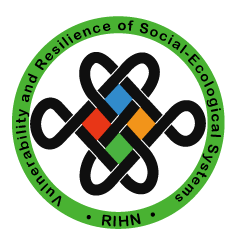Resarch Group
In order to achieve our objectives, we focus on four themes. Each four themes interlink each other and thus provide comprehensive assessment of resilience of social-ecological systems. Under the supervision of theme leader, respective researchers will participate in sub-programs. Not as ordinary discipline based research groups, we organized theme based research organization. Most researchers involve more than one sub-program, thus making it possible to realize flexible research organization.
Theme I: Ecological resilience and human activities under variable environment
This theme tries to capture the interaction between ecological resilience and human activities under fluctuating environment. In theme I-1, to evaluate the components, capacity and succession of ecological resilience, we will monitor spatial and temporal changes of soil conditions, e.g. organic materials and fertility related properties, succession of grass/shrub/tree communities, micro-climatic condition in above-ground and soil, and degradation of land that are expected to happen during the process of conversion from stable fallow woodland to agricultural land. In theme I-2, the influence of ecological resilience on human activities are revealed by comparison of some soil properties, which is related to ecological resilience, under different landscape, e.g. valley, slope and plane land, the types and histories of land use, and succession stages of agro-ecology.Theme II: Household and community responses to variable environment
Rural households in the semi-arid tropics have developed various kinds of risk-management and risk coping mechanisms to respond unpredictable rainfall. In order to serve for the integrated analysis of socio-ecological systems, the theme II investigates rural households’ strategies against the erratic rainfall in four interrelated sub-themes. Theme II-1 is to measure the risky event objectively, that is, rainfall. Theme II-2 concerns with the endowments of resources available to households including physical, natural, human, financial, and social capitals. Theme II-3 is devoted to the analyses of households’ behaviors: risk-management before the rain, adjustment during the rainy season, and risk-coping after harvest. And finally in theme II-4, households’ resilience in risky environment is evaluated in terms of income-smoothing, consumption-smoothing, and nutritious status.Theme III: Political-ecology of vulnerability and resilience: historical and institutional perspective
This theme tries to focus on the institutional aspects of social resilience in the area of semi-arid tropics. Social resilience undergoes change along with social, political and economic change and also with ecological change. It is important to understand both in the context of local history and physical settings. Theme III-1 tries to consider the change of economic policy and its impact on agricultural production and land use. Theme III-2 analyzes changes in socio-political and their impacts on land use. Theme III-3 investigates historical changes of drought responses and crop failures and the role of social institution to mitigate such situations.Theme IV: Integrated analysis of social-ecological systems
The primary goal of this theme is to clarify the relationship between ecological vulnerability, resilience and human activities through investigations of changes in land use and multi-level social/ ecological systems. Theme IV-1 analyzes continent scale climate monitoring to understand the mechanism of the formation of drought. Theme IV-2 investigates land use change and its impact on ecological system such as forest degradation and vegetation change using multi-temporal aerial photographs and satellite imageries. Theme IV-3 considers the role of actors of early warning systems and its effects on food security. Finally in theme IV-4 we analyze and evaluate regional resilience with district level data.| Last Update: 2013-02-07 15:36 JST | Jump to Top |  |
